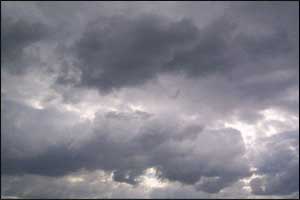- Home
- Editorial
- News
- Practice Guidelines
- Anesthesiology Guidelines
- Cancer Guidelines
- Cardiac Sciences Guidelines
- Critical Care Guidelines
- Dentistry Guidelines
- Dermatology Guidelines
- Diabetes and Endo Guidelines
- Diagnostics Guidelines
- ENT Guidelines
- Featured Practice Guidelines
- Gastroenterology Guidelines
- Geriatrics Guidelines
- Medicine Guidelines
- Nephrology Guidelines
- Neurosciences Guidelines
- Obs and Gynae Guidelines
- Ophthalmology Guidelines
- Orthopaedics Guidelines
- Paediatrics Guidelines
- Psychiatry Guidelines
- Pulmonology Guidelines
- Radiology Guidelines
- Surgery Guidelines
- Urology Guidelines
Cloudy and windy weather increases risk of heart attack: JAMA

Cloudy and cold weather could trigger a heart attack, finds a new study.
The largest study of its kind, published in the journal JAMA Cardiology, demonstrates that low air temperature, low atmospheric air pressure, high wind velocity, and shorter sunshine duration were associated with risk of myocardial infarction (MI).
David Erlinge, professor of cardiology at Lund University in Sweden, and colleagues conducted the study to determine if the weather is associated with a day-to-day incidence of heart attack.
Previous studies have reported increases in deaths from heart disease during winter, and recent research has linked the incidence of heart attacks to colder temperatures and snow.
“This is by far the largest study of weather and heart attacks. We are very interested in the triggers of heart attacks, because if you know those triggers you may be able to protect yourself," said Erlinge.
Also Read: Heart attacks more lethal during winters
The scientists speculate that cold weather could cause narrowing of arteries, putting extra pressure on the heart. “Cold and windy weather leads to a contraction of blood vessels in the skin to conserve energy and temperature,” said Erlinge. “That increases the workload of the heart, increasing the risk of a heart attack.”
Other possible explanations are changes in behavior during colder weather – alterations to diet or exercise habits, for example – or the increase in respiratory infections such as flu during winter, which have been associated with increased heart attack risk.
“Cold, windy weather also increases emotional stress, which is also coupled to the incidence of heart attack,” added Erlinge.
For the study, the researchers examined data from more than 274,000 patients across Sweden who had heart attacks between 1998 and 2013 for which contemporary weather data was available.
Also Read: Cold weather associated with increased mortality due to stroke
Key Findings:
- The incidence of MI increased with lower air temperature, lower atmospheric air pressure, higher wind velocity, and shorter sunshine duration.
- The most pronounced association was observed for air temperature, where a 1-SD increase in air temperature (7.4°C) was associated with a 2.8% reduction in risk of MI.
- Results were consistent for non–ST-elevation MI as well as ST-elevation MI and across a large range of subgroups and healthcare regions.
- The incidence of heart attacks was higher on days with air temperatures below freezing, with rates declining significantly when temperatures rose to greater than 3-4C.
- The association with air temperature also held true for different types of heart attack, including the most common type, which is caused by the blockage of a major coronary artery, an important blood vessel supplying the heart.
In studying the association of various weather parameters with heart attack risk, Erlinge and his team also took into account national data on air pollution, which has recently been linked to changes in heart structure. “We looked at data on air pollution in the three major Swedish cities every day during the 16 years,” said Erlinge. “Air pollution did not change the results reported in our study.”
"It remains unknown whether reducing cold exposure by staying indoors and/or wearing warm clothes could reduce the risk of heart attack, and that this would need further investigation," caution the authors.
For further reference follow the link: 10.1001/jamacardio.2018.3466

Disclaimer: This site is primarily intended for healthcare professionals. Any content/information on this website does not replace the advice of medical and/or health professionals and should not be construed as medical/diagnostic advice/endorsement or prescription. Use of this site is subject to our terms of use, privacy policy, advertisement policy. © 2020 Minerva Medical Treatment Pvt Ltd